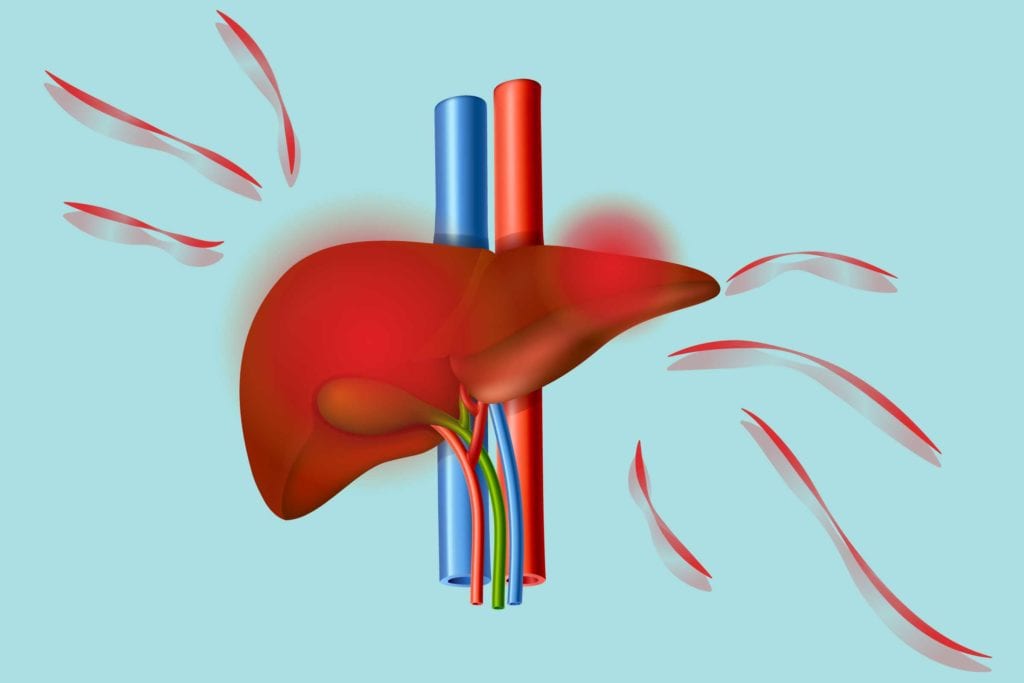

Inflammatory arthritis, by definition, affects the body’s joints. But the effects of the inflammation from arthritis — and the medication used to treat it — can be much more far-reaching. Case in point: Studies have linked certain types of inflammatory arthritis with a greater risk of developing nonalcoholic fatty liver disease (NAFLD). You may never have heard of this increasingly common condition, but it’s important to understand what fatty liver disease is and how to prevent and treat it.
What Is Nonalcoholic Fatty Liver Disease?
Nonalcoholic fatty liver disease (NAFLD) occurs when fat accumulates in liver cells and the deposits aren’t the result of alcohol abuse. The acronym NAFLD actually encompasses several conditions. There can be fat deposits in the liver that remain fairly harmless, and this is simply called NAFL (nonalcoholic fatty liver).
But NAFL can progress to nonalcoholic steatohepatitis (NASH), which is an inflammation of the liver; it’s considered the progressive form of NAFLD. And NASH, in turn, can lead to fibrosis (liver scarring), cirrhosis (more extreme liver scarring), and liver cancer. For obvious reasons, it’s best not to start down this path at all.
Nonalcoholic fatty liver disease has become the most common cause of chronic liver disease in the U.S. and worldwide. According to the National Institutes of Health, an estimated 30 to 40 percent of adults in the United States have NAFLD, and about 20 percent of them have NASH.
Symptoms of Nonalcoholic Fatty Liver Disease
Since there are rarely any symptoms for nonalcoholic fatty liver, most people are unaware their livers are compromised. This is why it’s important for doctors to look for it among people who may be at increased risk. Some symptoms, which are vague, include:
- Enlarged liver
- Fatigue
- Pain in your upper right abdomen
Advanced cases of fatty liver disease may cause additional symptoms, including:
- Swelling in your abdominal area
- Enlarged blood vessels
- Enlarged spleen
- Jaundice (yellowing) of the skin and eyes
What Causes Nonalcoholic Fatty Liver Disease?
Risk factors most commonly linked with NAFLD are obesity, diabetes, and metabolic syndrome (a cluster of conditions — including high blood pressure, high blood sugar, high cholesterol, and central obesity — that raise the risk for heart attacks, strokes, and other health problems). Among people who have diabetes and obesity, the rate of NAFLD is estimated to be as high as 60 to 90 percent.
“It’s very prevalent,” says Nilanjana Bose, MD, a rheumatologist with the Rheumatology Center of Houston. “It’s likely a combination of the Western diet, which is high in carbs and fat; a sedentary lifestyle; and certain medications. My patients with rheumatoid arthritis, psoriatic arthritis, ankylosing spondylitis, gout, and osteoarthritis can all have fatty liver.”
How Does Arthritis Affect Your Risk of Fatty Liver?
Considering how common fatty liver is, it’s not surprising that it affects patients with inflammatory arthritis. “About one-third of U.S. adults have NAFLD, so a minimum of one-third of patients with inflammatory arthritis should also be having NAFLD,” says gastroenterologist Rohit Loomba, MD, director of clinical research at the University of California, San Diego, and co-chair of the National Research Committee for the American Liver Foundation.
But having certain types of inflammatory arthritis may be a separate risk factor for fatty liver disease. One reason may be the inflammation underlying these conditions. “There’s a new concept emerging in medicine called meta-inflammation,” explains Dr. Loomba. “If you have an inflammatory condition in one part of the body, you may have similar inflammation in multiple domains.” The liver is one of those domains.
The link between inflammatory arthritis and NAFLD appears to be strongest with psoriatic arthritis. “Patients with psoriasis and psoriatic arthritis have a very high risk of NASH and also fibrotic disease,” says Dr. Loomba. There’s some evidence that patients with rheumatoid arthritis may be at slightly higher risk of developing the condition, too.
Taking methotrexate, a disease-modifying drug commonly used to treat rheumatoid arthritis and some other inflammatory arthritis conditions, has also been linked to NAFLD, as methotrexate can be toxic to the liver. That’s why doctors monitor your liver health closely while you take methotrexate. It’s also why you’re cautioned to avoid alcohol or limit your intake while on methotrexate.
Fatty Liver Disease and Psoriasis and Psoriatic Arthritis
People with these inflammatory conditions may be particularly at risk of NAFLD and liver damage. For one thing, psoriasis and psoriatic arthritis have been linked with obesity, diabetes, and metabolic syndrome — all risk factors for NAFLD. A study at the University of Pennsylvania Perelman School of Medicine in Philadelphia, reported in a 2017 issue of the Journal of Investigative Dermatology, found that people with psoriasis and psoriatic arthritis were at increased risk for liver disease, including NAFLD, whether or not they were taking systemic therapy, such as methotrexate. The risk was even higher for those who were. It’s estimated that almost half of patients with psoriasis may have NAFLD.
Fatty Liver Disease and a Possible Link to Rheumatoid Arthritis
The link between RA and nonalcoholic fatty liver disease seems less definite, and studies have had conflicting results. Research presented at the 2006 annual meeting of the American College of Rheumatology, for instance, found NAFLD to be common in RA patients when compared with a control group, but the difference wasn’t enough to be statistically significant.
A decade later, in 2016, another study presented at the American College of Rheumatology’s annual meeting found that the “usual” risk factors, such as metabolic syndrome, still accounted for the highest risk, even among RA patients. Current use of methotrexate also raised the risk.
Monitoring and Diagnosis for Fatty Liver Disease
Since there are few to no symptoms of NAFL, doctors must determine which patients are at increased risk when deciding to monitor for the condition. Many dermatologists routinely screen their psoriasis patients. Some rheumatologists make liver testing a routine part of their practice, too. “I always do a liver function panel [blood test] at baseline to make sure patients are ready if I need to put them on meds,” says Dr. Bose. The blood tests are also used for monitoring drug treatment.
Other rheumatologists screen or monitor for NAFLD on a case-by-case basis. “Somebody who is taking a high dose of methotrexate. Somebody with psoriasis who also has type 2 diabetes. Someone age 50 or older with diabetes and another inflammatory condition. In cases like these it’s probably reasonable for the liver to be evaluated,” says Dr. Loomba.
A blood test with a complete metabolic profile is the first step. “Ask ‘What is my ALT [alanine transaminase],’” advises Dr. Loomba. ALT is an enzyme primarily found in the liver; high levels in the blood may indicate a liver problem. Imaging scans like ultrasounds, CTs, or MRIs can diagnose NAFLD. In fact, many times NAFLD is detected incidentally, when someone has an abdominal scan for another reason.
And when the progressive form of NAFLD is suspected, a liver biopsy can show evidence of NASH. Newer and better imaging techniques like MRE — magnetic resonance elastography — are allowing some patients to avoid biopsies, although the new technology isn’t widely available yet. Other noninvasive diagnostic techniques are also being studied.
Dr. Loomba explains that diagnosis involves determining if there is simply fat in the liver, or if there is also scarring, which means the patient has developed the progressive form of the disease. Doctors try to determine whether the patient is at risk of developing cirrhosis — and what kind of intervention is necessary.
Prevention and Treatment of Fatty Liver Disease
“If you lose weight and exercise you can improve fatty liver disease,” says Dr. Loomba. “It’s reversible.” Vitamin E supplements are sometimes recommended (under a doctor’s direction), but lifestyle changes are considered the best way to combat NAFLD. “I advise my patients to follow a Mediterranean diet, which involves cutting back on carbs, sugars, and red meat; start a low-intensity aerobic exercise program; and avoid alcohol and NSAIDs,” says Dr. Bose. “Nonalcoholic fatty liver disease is preventable and treatable, and these same lifestyle measures can help arthritis, too.”
There are no FDA-approved drugs for NASH, the progressive form of NAFL. “But there are about 50 different therapies in various stages of clinical trials,” says Dr. Loomba.
Patients who are at high risk of developing NAFLD may need to alter their arthritis medications. “Methotrexate can be toxic to the liver, but it’s dose dependent,” says Dr. Loomba, explaining that patients on the drug can be closely monitored for signs of liver disease.
Patients taking methotrexate may need to switch medications in order to protect the liver, “especially if they are obese,” says Dr. Loomba. NSAIDs have also been implicated in liver damage, so physicians and patients must carefully weigh the risks and benefits of all available drugs.
It is important to take steps to prevent or reverse NAFLD. “Cirrhosis due to NAFLD/NASH is increasing in the U.S. and worldwide,” says Dr. Loomba, adding that the risk of liver cancer is also increasing in the U.S. and also globally.
The good news, though, is that fatty liver disease can be prevented, treated, and even reversed, with weight loss, proper diet, lifestyle changes, and working with your doctor on a safe treatment regimen.





